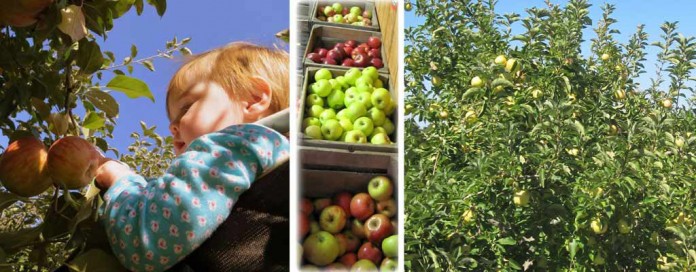It’s apple season! I made my first batch of apple butter from home grown apples over the weekend. The sweet smell of baked apple, spicy ginger, cloves and cinnamon reminded me that apples are the perfect backyard fruit.
Fall is a great time to plant apple trees in USDA Hardiness zones 5-10. Here are a few tips to help you choose the right apple trees to plant this fall.
5 tips to plant apple trees this fall
- Cold- hardy varieties. When planting apples in fall it is a good idea to choose cold-hardy varieties. Last fall I added Cortland Apple Trees to my young fruit orchard. My trees made great strides in spring and are looking healthy and strong after a summer of growth.
- Pollination requirements. Most apple trees require at least two cultivars for cross-pollination. Planting multiple varieties of apple trees is recommended. For best results plant trees less than 100 feet apart.
- Pick the right size tree for your space. Standard trees can grow to be 25’ tall and 20’ wide. Semi- dwarf can be 15’ tall and wide, and dwarf 10’ tall and wide.
- Fruiting schedule. The earliest apples are ready to harvest in early summer. Late apple varieties are ready to pick in late fall. I included multiple apple varieties in my orchard to provide me with a steady supply of apples all season long.
- Protection from wildlife. Pests love fruit as much as humans. Fencing, netting and other barriers deter large pests. Trunk guards offer ground level protection, and mulch insulates roots over winter.
How to plant apple trees
- Choose a site with plenty of space, full sunlight and good soil.
- Soak new trees in water for a couple hours before planting.
- Dig a hole that is deep and wide enough for roots to spread out.
- Shovel soil into a large container. Mix in nutritious compost, fertilizer or other amendments for a rich loamy backfill that will optimize root establishment.
- Plant tree. Backfill with amended soil. Tamp down to minimize air pockets.
- Water thoroughly.
- Add a layer of mulch 1 foot around the tree trunk.
How to care for apple trees
Cut apple trees to a max height of 28” after planting.
Prune apple trees in very early spring. The goal of pruning is to develop strong limbs and achieve a good shape. Honor the strong central leader by pruning off any vertical growing limbs. Make clean cuts to remove all but four lateral branches plus the central leader.
Stake developing trees as needed.
In years that follow, prune your apple trees into a vase shape. Allow the central leader to develop to full height. If fruit is developing poorly or too heavily, thin limbs when your tree is fruiting.
Pests and disease
Commercial growers use organic and non-organic fruit tree sprays to guard against pests and disease and achieve picture perfect apples. Home growers may choose not to spray. I do not spray my trees and suffer some fruit losses each season as a consequence. My apples are often splotchy and discolored, but taste just as good! If you choose to spray, follow the fruit tree spray manufacturer’s professional program as directed.











